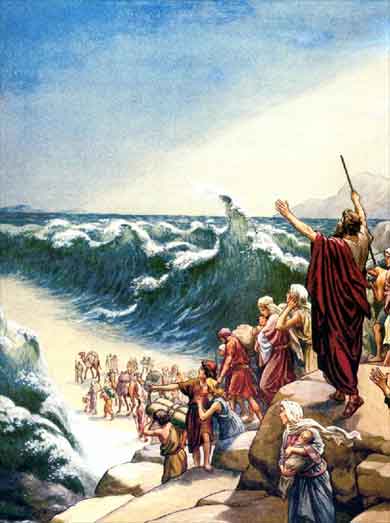
From the Discovery Channel:
The European settlers who were present at the first Thanksgiving in 1621 thought the Native Americans were wild Israelites who had lost their "civilized" ways after living in the New World wilderness, according to a U.S. historian.
The theory, which is outlined in a recent press release and is supported by several other American colonial history scholars, suggests one reason why tensions often mounted between the Native Americans and the Europeans.
It also foreshadows the later missionary work by other Europeans, many of whom felt they were turning the Native Americans back to their former beliefs. (Ed: why did these people always feel like they had to change other peoples spiritual belief?)
"The Europeans thought the Native Americans were a lost Israeli tribe that had been blown off course and landed in America," said Mark Miller, a history professor at Roanoke College in Virginia who specializes in American history from the colonial and Civil War periods. "They thought the tribe arrived as civilized men and women, but became savages after living in the wilderness."
Miller added, "For fear of contact with the savages, laws were enacted which forbade European settlers to touch or look at the Indians."
According to the Web site of The Nahum Goldmann Museum of the Jewish Diaspora in Tel Aviv, Israel, the European settlers believed in the lost "Ten Tribes of Israel," and likely thought that one of these missing tribes wound up in America.
These tribes were said to be part of the original twelve 12 that conquered Canaan, believed to be "the Promised Land."
The Assyrians, in turn, conquered the Kingdom of Israel in 721 B.C. This resulted in either the assimilation or deportation of the tribes of Israel. The tribes' fate was never fully documented, so the Pilgrims thought anything was possible.
According to the site, the supposed Israelite-Native American link remained popular through the late 18th century, during which time European exploration of the continent increased, as did necessary trade with Native Americans.
Carolyn Travers, research manager at Plimoth Plantation, a Plymouth, Mass. living history museum that recreates Pilgrim-era life, told Discovery News that she agreed some, if not all, of the Pilgrims thought the Native Americans hailed from Israel.
"They had to come from somewhere, and the lost tribe origin struck them as being very plausible and authoritative," said Travers. "You must try to imagine the mindset of the time. The Europeans were expecting wild beasts and wild men in the New World. There even were rumors in England about people here with no heads or feet."
Travers added that the settlers, who initially called themselves "Saints" and not "Pilgrims," were extremely religious individuals.
"They prayed in the morning, prayed before eating, prayed after eating and during in-between times," she said, "so it makes sense that they often viewed their world in Biblical terms."
Travers, however, said she does not believe many laws forbade contact between the settlers and Native Americans, since she said they went into each other's homes to trade items and for other purposes.
"It would be hard to hand an object over to someone and not look at the person's face," she said.
The Native Americans, who held their own spiritual views, thought of the Europeans in political terms, according to the new book Subjects Unto The Same King by Brigham Young University history professor, Jenny Hale Pulsipher (Ed. Of course, the Mormons have some odd beliefs about Indians all their own).
Pulsipher said the Pilgrims landed in an area occupied by the Wampanoag tribe. The Wampanoags, weakened by epidemics and threatened by another tribe to the south called the Narragansett, welcomed friends with guns (Ed. Now, there is an odd contention considering the Wampanoags didn't have any guns).
"The Indians didn't have the kind of racial solidarity that we tend to project onto the past," said Pulsipher. "The Pilgrims were another group, and the Wampanoags were happy to make an alliance with them, and it served both group' interests."
The alliance obviously did not last. Tensions mounted as the settlers continued to encroach on Native American territory but, for the harvest celebration in 1621 that now is referred to as the first Thanksgiving, the two groups joined forces for a meal that included corn, fowl and venison during celebrations that lasted for three days. (Ed: A different perspective: William B. Newell, a Penobscot Indian and former chairman of the Anthropology department at the University of Connecticut, says that the first official Thanksgiving Day celebrated the massacre of 700 Indian men, women and children during one of their religious ceremonies. "Thanksgiving Day" was first proclaimed by the Governor of the then Massachusetts Bay Colony in 1637 to commemorate the massacre of 700 men, women and children who were celebrating their annual Green Corn Dance...Gathered in this place of meeting, they were attacked by mercenaries and English and Dutch. The Indians were ordered from the building and as they came forth were shot down, The rest were burned alive in the building-----The very next day the governor declared a Thanksgiving Day.....For the next 100 years, every Thanksgiving Day ordained by a Governor was in honor of the bloody victory, thinking God that the battle had been won.")
No comments:
Post a Comment